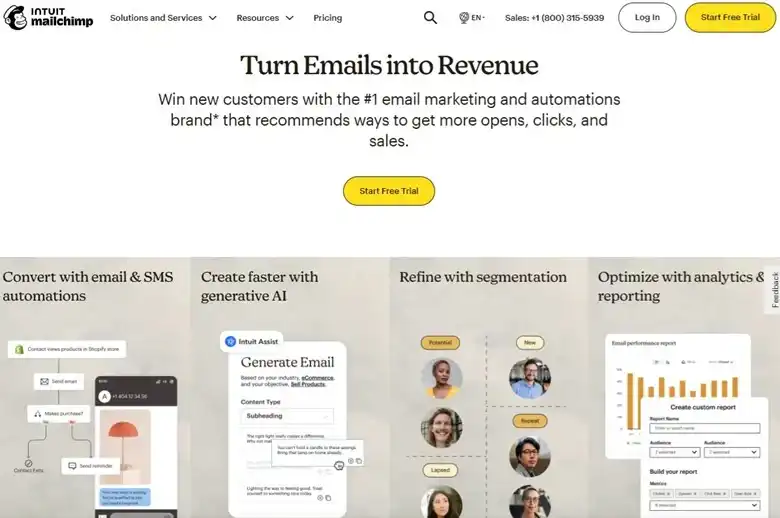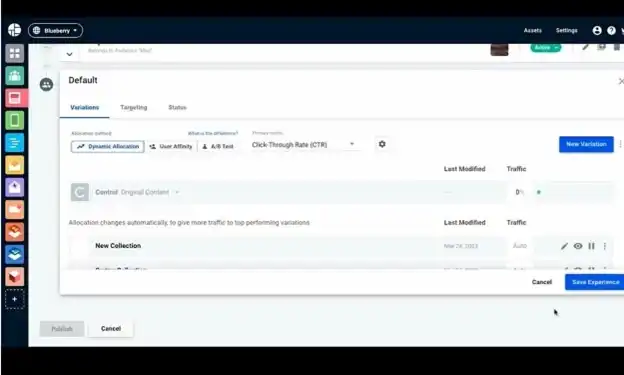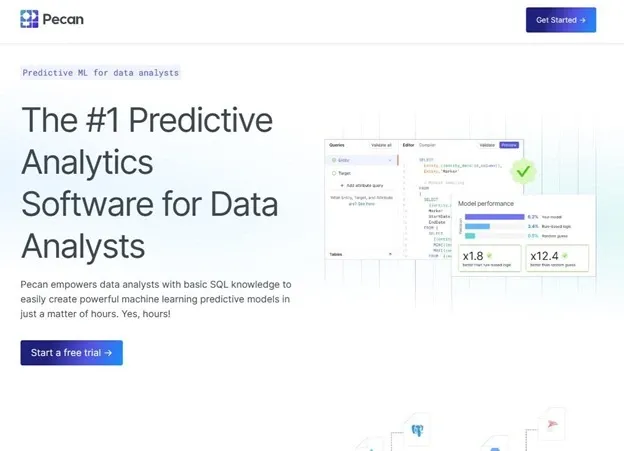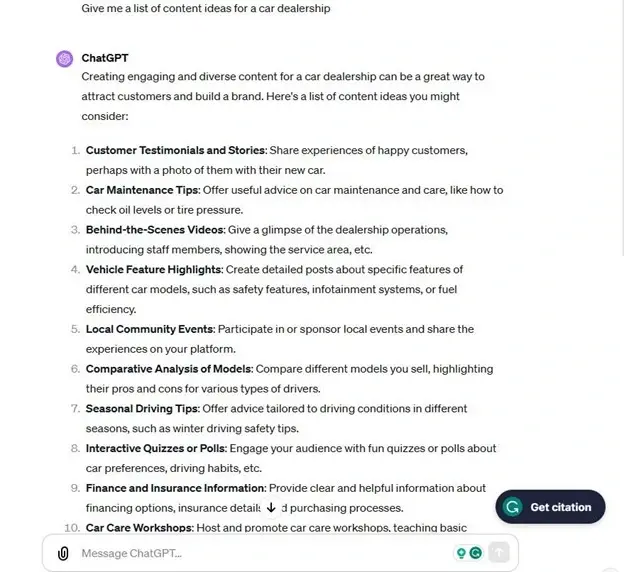8 AI Marketing Trends for 2024 and Beyond (+ Tips & Ideas)
- Home
- Intelligent Insights Blog
- 8 AI Marketing Trends for 2024 and Beyond (+ Tips & Ideas)
Artificial intelligence (AI) is here to stay and will only become more relevant in the coming years.
Yet, if you’re already using AI for marketing, you’re probably aware of the challenges it presents.
For example, you can use AI to collect and analyze data. But sometimes the data is poor quality. You can use it to generate content, but sometimes the content is poor quality.
You may struggle to integrate AI with your existing marketing strategies. And there may be a lack of understanding and trust in AI among your marketing team.
While many marketers face these challenges, there are ways to still use AI to your advantage.
That’s why we’ve outlined 8 important AI marketing trends and tips. Read on to learn about these trends and how to leverage them for better PR and marketing results.
Ready to see how your PR and marketing strategy could benefit from AI?
Let us help. Book a free consultation with one of our marketing and PR experts. We’ll take a look at your current marketing and PR mix to see where it could benefit most from an AI boost.
Our Curated AI Marketing Trends for 2024
- Public Relations
- Thought Leadership
- Personalized Customer Experiences
- Voice and Conversational AI
- Predictive Analytics
- AI-Generated Content
- Automated Decision-Making
- Ethical AI and Privacy Compliance
- Virtual Reality and Augmented Reality
1. AI Can Power Your Public Relations Efforts
Public Relations (PR) brings many advantages to your brand. But what makes it one of the top AI marketing trends?
AI can help with a lot of the necessary things that result in great PR including:
- Finding and matching you with relevant journalists or publications.
- Monitoring your media mentions and those of your competitors.
- Curating trends and articles that are making a splash in your industry.
- Generating first draft pitches to send to journalists based on input.
- Keeping track of your wins and giving you insights into what’s working.
To get started with AI for PR, you can use free tools online such as ChatGPT, or you can use a tools like Intelligent Relation’s Preston platform. Preston allows you to do all of the above, making AI PR easy.
Here is a snapshot of Preston in action, so you can see how it works:

Pro Tip: Be careful when using generative AI to write PR pitches or posts. AI isn’t perfect. It’s still best to proofread and edit generated content. Remember that journalists appreciate personalized, valuable pitches. It won’t get you very far if your pitches aren’t on point.
Excited to get started on a PR strategy for your brand? Then you’ll want to get started on the right foot. Check out our comprehensive guide: How to Write an Effective PR Plan [Tips + Examples]
2. AI Can Streamline Your Email Marketing Campaigns
Who has time to write thousands of emails to individual customers? No one. That’s why using AI for email marketing is one of the key AI marketing trends for 2024.
How does it work?
For starters, using AI helps you segment your email lists. That way, you know that the right message is reaching the right customers. You can segment based on individual preferences, demographics, or customer behavior.
Additionally, AI can determine the appropriate time to send emails to your subscribers. It can examine patterns of when customers open their emails, including time zones. This can help improve customer engagement and retention rates.
When using AI tools for email marketing, consider customer engagement with your previous emails. This helps ensure that customers receive the right content at the right time.
You can also use AI tools such as ChatGPT to craft compelling subject lines and email copy. Just ensure that it aligns with your brand and your customers’ interests.
Here is an example of AI in email marketing from MailChimp:

Pro Tip: Try A/B testing your email marketing efforts. That includes the effectiveness of your subject lines, email content, calls to action, and send times.
Want a deeper dive on email marketing trends for 2024? Then you’ll want to check out our article: 8 Email Marketing Trends and Best Practices for 2024 [+ Tips]
3. Personalized Customer Experiences Are Made Possible with AI
Why are personalized customer experiences among the top AI marketing trends? AI is increasingly being used to tailor content, recommendations, and interactions to individual preferences and behaviors.
In fact, about 92% of businesses use personalization driven by AI.
This boosts engagement by creating interactions that are relevant and meaningful to each individual. Personalization also enhances customer loyalty and retention. When customers feel valued and understood by a brand that caters to their individual needs, they’re more likely to stay loyal.
Additionally, personalized experiences typically result in higher conversion rates. AI-driven personalization enhances upselling and cross-selling opportunities, which helps increase sales.
For effective personalized experiences in AI marketing, actively collect comprehensive customer data from various touchpoints. You’ll need to use AI tools to collect and analyze this data.
This data should come from various touch points such as purchase history and web browsing behavior. The data should then be cleaned, organized, and given categorical variables. Some of the most popular tools for this include Tableau, Microsoft Power BI, and Dynamic Yield.
Below, you’ll find an example of AI personalization from a tool called Dynamic Yield:

Pro Tip: Continuously test and refine your personalization strategies. Adapt your AI algorithms and tactics based on customer feedback and evolving behaviors. This helps ensure that personalization remains relevant and effective over time.
4. Voice and Conversational AI Provide Convenience in Customer Service
The rise of voice assistants and chatbots has revolutionized customer service and engagement. These technologies represent the forefront of AI marketing trends. They enable natural interactions through voice and conversational AI.
How does adopting this as one of your AI marketing trends benefit you?
Chatbots and voice assistants offer 24/7 support, answering queries and providing assistance at any time. This availability improves accessibility and enhances the overall customer service experience.
Additionally, chatbots automate routine tasks in customer interactions. This automation reduces the burden on human staff, which helps increase operational efficiency. Plus, your team is freed up to respond to the queries that require human attention.
Integrating voice and conversational AI systems into an omnichannel marketing strategy is also vital. This integration provides a cohesive experience across different platforms. It allows for consistent messaging and better personalization.
When choosing a solution, it’s crucial to select tools that can train themselves quickly. While you can train AI tools yourself to send a unique message, the process can be time-consuming. Instead, you might consider an out-of-the-box solution like Zowie that learns as it goes along.
Here is an example of the type of chatbot you get with Zowie or similar tools:

Pro Tip: Make sure whatever solution you’re using regularly updates to keep pace with new trends, slang, and evolving customer preferences. Continuous improvement is key to maintaining the relevance and effectiveness of AI in customer interactions.
5. Predictive Analytics with AI Makes Marketing Efforts More Impactful
Predictive analytics is one of top AI marketing trends because you can use it to enhance targeting and your understanding of customer behavior. In turn, you can anticipate market trends and customer needs.
It enhances targeting by analyzing your customers’ patterns. The insights from this analysis is essentially a forecast of future market changes and consumer needs. You can use these insights to tailor your campaigns and adapt your strategies proactively, increasing both your relevance and effectiveness.
Using predictive analytics in marketing campaigns also improves resource allocation efficiency. This allows marketers to optimize marketing spend and focus on the most promising opportunities.
When implementing predictive analytics as one of your AI marketing trends, be sure to integrate diverse data sources. You might include customer demographics, purchasing history, online behavior, and social media interactions. A rich dataset leads to more accurate predictions and better-targeted strategies.
Continuously learn and refine your AI models to stay current with market trends and customer behaviors. This ensures that your predictive insights are relevant and precise.
Pecan is a popular AI tool used for predictive analytics. Here is an example of what it looks like:

Pro Tip: Balance predictive analytics’ automated insights with human expertise. Use AI-driven analysis as a guide but apply human judgment and industry knowledge to interpret the data. This will help lead to more effective marketing decisions.
5. AI-Generated Content is Streamlining Marketing Content Creation
What makes AI-generated content one of the most innovative AI marketing trends? Because marketers can use it to write everything from product descriptions to creative ad copy.
More than half of marketers have used AI-generated content and reported positive results.
AI-generated content significantly enhances content production efficiency and scalability. It enables the rapid creation of large volumes of content. This is particularly beneficial for businesses with extensive and diverse content needs.
Additionally, AI tools ensure consistency in tone and style across all content. This is important for maintaining a consistent brand identity and optimizing content for search engines.
When using AI-generated content, be sure to include your own human creativity. Use AI for initial drafts or idea generation, then have human editors refine and personalize the content.
ChatGPT is one of the most popular AI content generators. Here is an example of how it works:

Pro Tip: Always review and edit AI-generated content for accuracy. In some cases, AI produces outdated or inaccurate information known as “hallucinations.” Be sure to fact-check certain information and change or update it if necessary.
Need some fresh ideas for content marketing in 2024? Then you’ll want to check out our article: 7 Top Content Marketing Trends 2024 [+ Tips and Tricks]
6. Automated Decision-Making Streamlines Data Analysis and Marketing Decisions
AI algorithms are assisting in making real-time decisions on ad placements, content distribution, and even pricing strategies. That’s why AI automated decision-making one of the most important AI marketing trends of 2024.
Automated decision-making speeds up data analysis and marketing decision processes. It enables real-time campaign adjustments and swift responses to market changes.
That’s because AI algorithms process data more accurately and consistently than humans. This reduces errors and ensures decisions are based on thorough analytics and insights.
Automation also allows for the scaling of marketing efforts without a corresponding increase in resources or labor. It efficiently handles large-scale campaigns and complex decision-making. Plus, it optimizes resource allocation and frees time for human marketers.
Before implementing automated decision-making in AI marketing, define your objectives and set specific parameters for the AI. This ensures that the AI’s decisions align with your marketing goals and avoid irrelevant choices.
Regularly monitor and review the AI’s decisions for effectiveness and accuracy. Stay alert to any anomalies or errors and confirm that the outcomes meet your goals. Integrate AI’s automated decision-making with human oversight and expertise.
IBM offers one of the best automated decision-making tools infused with AI. Here is an example:

Pro Tip: When using AI for data processing and trend identification make sure you’re still using human judgment. A human should interpret the results and make the major strategic decisions. AI shouldn’t replace your human employees, it should make their jobs easier.
7. Ethical AI and Privacy Compliance is Key to Gaining Consumer Trust
With growing concerns about data privacy and ethical AI usage, more companies are focusing on transparent and responsible AI practices. That’s why ethics and privacy compliance are among the most important AI marketing trends.
Prioritizing ethics and data privacy helps build and maintain consumer trust. Transparent and ethical handling of data reassures customers about the safe and responsible use of their personal information.
Complying with ethical guidelines and data privacy laws ensures adherence to legal standards, such as those laid out in the Blueprint for an AI Bill of Rights. This can help you avoid fines and promote an image of responsibility.
Clearly communicate to your customers how you collect, use, and protect their data. Make your data practices transparent to build trust and give customers more control over their personal information.
Regularly review and update your privacy policies to keep pace with evolving data privacy laws and ethical standards. This shows customers your commitment to protecting their privacy.
Here is an example from OpenAI on how to be transparent about your privacy policies:

Pro Tip: Educate your team about the importance of data ethics and privacy in AI marketing. Provide regular training and updates on ethical practices and legal compliance. Be sure to foster a culture that prioritizes customer privacy and ethical data usage.
8. Virtual Reality and Augmented Reality are Becoming Integrated with AI
Augmented Reality (AR) and Virtual Reality (VR) are revolutionizing AI marketing. They offer immersive product demonstrations and virtual try-ons, making them one of the top AI marketing trends.
While many brands use virtual assistants (VAs) powered by AI and VR to enhance shopping experiences, that’s not the only use case.
For example, the World Health Organization uses a VA named Florence as a health advisor. It offers interactive guidance on stress management, healthy eating, COVID-19 vaccines, and more.
Meanwhile, marketers are also leveraging digital avatars to create more realistic and engaging interactions, significantly improving user experiences.
Essentially, these technologies enable you to create interactive marketing campaigns and personalized shopping experiences. How do you get started?
Use VR and AR to create interactive experiences that actively engage users. For example, design virtual showrooms or augmented product trials that encourage users to explore and interact with your brand.
Integrate AI with VR and AR to offer personalized experiences. Use data analytics to tailor virtual environments or augmented reality features to individual user preferences and behaviors, enhancing relevance and appeal.
When using AR to create images of your products, you’ll need to remove the background. This allows potential customers to view your products in a useful setting.
One AR tool that uses AI to create captivating product visuals is Clickdrop. An example of AI used in AR is Clickdrop’s AI editing tool:

Pro Tip: Employ VR and AR to tell compelling brand stories. Create immersive narratives or environments that resonate emotionally with users. This type of experience allows you to build a stronger, more memorable brand connection with customers.
Key Takeaways on the Latest AI Marketing Trends
Whether we like AI or not, it’s become an increasingly integral part of PR and marketing. It can do everything from collecting data to providing tailored customer service. That’s why using it can give you a competitive advantage.
Yet, successfully integrating AI into existing marketing strategies does require overcoming technical and human challenges. You must learn how to integrate AI with human creativity and attention. That includes educating marketing teams on how to leverage AI. Despite these challenges the pay offs are worth it.
The important thing to remember is that AI marketing trends will continue to evolve in 2024. To stay ahead, it’s important to keep an ear to the ground. This can be achieved through professional development, industry conferences, webinars, and online forums. Or even reading articles like this one.
Want help integrating AI into your PR and marketing strategies? Let us help! Simply book a free consultation and we’ll take a look at your current strategy to see where it could benefit from AI.

